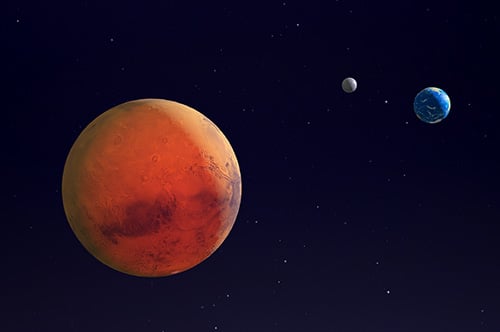
As the opening keynote speaker at the upcoming AIAG Supply Chain Summit on June 18, 2019, Michael Galluzzi, NASA’s principal Investigator and subject matter expert on supply chain management and logistics engineering in the Exploration Research and Technology Program at the Kennedy Space Center, will share recent NASA supply chain lessons learned and how these can be applied to automotive supply chain initiatives. A talk that covers the practical as well as the visionary, Galluzzi will provide intriguing insights on technologies that will impact the U.S. manufacturing base in the near future, as well as ideas from NASA’s approach to supply chain management that could advance not only the auto industry, but also the U.S. industrial supply base.
 Galluzzi joined NASA in 2004 as the supply chain manager in the Space Shuttle Program Office, ultimately managing the termination and retirement of the space shuttle. He is a recognized supply chain management and industrial base management subject matter expert, who has directly supported senior level management at NASA HQ Office of the Chief Engineer in Washington, DC. Among the various projects he supports, Galluzzi is chiefly focused on the NASA Moon to Mars initiative announced earlier this year, assessing technologies that can enhance the support posture of In-Situ Resource Utilization (ISRU) and planetary surface system hardware.
Galluzzi joined NASA in 2004 as the supply chain manager in the Space Shuttle Program Office, ultimately managing the termination and retirement of the space shuttle. He is a recognized supply chain management and industrial base management subject matter expert, who has directly supported senior level management at NASA HQ Office of the Chief Engineer in Washington, DC. Among the various projects he supports, Galluzzi is chiefly focused on the NASA Moon to Mars initiative announced earlier this year, assessing technologies that can enhance the support posture of In-Situ Resource Utilization (ISRU) and planetary surface system hardware.
Q: What are some supply chain challenges that NASA and the auto industry have in common?
Galluzzi: Our customers are expecting on-time delivery of a quality product and at a reasonable cost every time, regardless of the extended supply chain distance. NASA’s supply chain, however, can extend as few as 400 miles at Low Earth Orbit (LEO), to 225,000 miles (Moon at perigee), to several million miles in the case of Mars, which is 33.9 million miles at its closest point. In this common challenge, we also have a common goal: to develop new technologies that can provide an on-demand, 100-percent fill rate.
Both industries would be well served with objective Key Performance Indicators that offer a better understanding of supply chain responsiveness to new technology, such as introductions for rapid, on-demand sourcing — specifically, 3D printing technology. Understanding and having visibility into 3D printing “technology readiness” will allow for better product requisition cycle time, product demand planning, source identification, and quality control. Even more importantly, it will allow for optimized obsolescence mitigation, assuming 3D printed product quality and material characterization can be assured.
Q: What are some of the potential impacts that 3D printing could have on the manufacturing supply chain in general?
Galluzzi: I believe that if we are not meticulous about monitoring the 3D print technology adoption rate as a preferred source of supply to select products, we may find product obsolescence exacerbated in other components still requiring traditional CNC manufacturing. Lower product demand as a result of sourcing 3D printed products may translate into reduced supplier liquidity as a whole, possibly creating additional sole-source situations or supply chain disruption.
Q: Can you point to some examples of NASA’s work in this area?
Galluzzi: With regards to NASA and challenges with Lunar Operations specifically, we are diligently working to mature additive manufacturing technologies to support on-demand, in-space manufacturing. We are creating these new manufacturing processes using In-Situ Resource Utilization (ISRU), regolith-based additive manufacturing — in short, using “lunar dirt” as feedstock or extracting various metals from regolith for in-space manufacturing of replacement parts or other infrastructure needs to other mass transformation, e.g. propellant, water, etc.
Q: Any other shared challenges between NASA and the auto industry?
Galluzzi: A common non-technical challenge is ensuring a common data architecture is “threaded” within the various system designs and different organizational functions, e.g. design engineering, logistics, procurement, suppliers, safety and mission assurance, quality, and contracts. A consistent data architecture with information system (IT) integration is a required foundational element to allow for better accuracy in hardware and supplier commonality, asset management, and economic order quantity to timely procurements. As important, it allows for advanced intelligent data analytics and supply chain “war gamming”; in NASA’s case, a high-fidelity analysis of cis-lunar-to-lunar logistics nodal positioning of spares, material feedstock, regolith-based additive manufacturing, or component harvesting/cannibalization opportunities.
A common data architecture will allow for enhanced vertical chain visibility. With this capability in hand, we can create the circumstances for a resilient supplier base, which among other things, will improve product quality. A major difference with the commercial industrial sector is that cost efficiencies or savings can be monetized. When industry multiples are considered, those savings can add up and significantly impact the bottom line and overall valuation of the company.
Q: When it comes to supply chain initiatives, what is taking up most of your time and energy right now?
Galluzzi: My current focus is on defining the NASA Kennedy Space Center Space Logistics Research and Development portfolio and creating a strategic roadmap to achieve the goals of supporting the NASA Moon to Mars initiative announced earlier this year — specifically, assessing technologies that can enhance the support posture of ground and space flight systems. My goal is to increase the probability of mission success, reduce program risk, reduce system life cycle cost, and reduce the logistics footprint. At a high level, my focus is on:
- Product Lifecycle Management (PLM)
- Product Data Management (PDM)
- In-Space Logistics Mass Reduction through Regolith-based Additive Construction, In-Space Manufacturing
- Intelligent Supply Chain Analytics and applying the “Digital Twin Theory” for Space Application.
Q: What will be the main topics in your remarks at the upcoming Supply Chain Summit? What can attendees expect to take away?
Galluzzi: The emphasis is on Space Shuttle Lessons Learned and design impact to support operations, including product termination and retirement and its potential impact in support of new designs. I will also discuss intelligent network modeling and visualization with the Space Shuttle as an example of a fluctuating industrial base. Additional topics in the presentation include the importance of vertical chain visibility; sequencing multi-commodity network flow to logistics nodal positioning; and understanding supplier economic liquidity and supply chain resilience modeling.
I will also talk about the advances in regolith-based additive manufacturing and whether it is our key to reducing an Earth-based source of supply. And finally, I’ll wrap up with a Supply Chain Value Proposition.
Q: What has NASA learned from the automotive industry? And what can the auto industry learn or borrow from NASA when it comes to supply chain?
Galluzzi: NASA has a very strong relationship with the automotive industry. An example that comes to mind is the Robonaut (R2) currently on the International Space Station, a partnership to accelerate development of the next generation of robots and related technologies for use in the automotive and aerospace industries.
Relating to supply chain management, our industries can collaborate in advanced manufacturing and a fundamental exercise in basic economics of how product demand frequency or infrequency impacts supply; from sole source risks, obsolescence, and counterfeit parts have been good lessons-learned observations. The launch rate of the Space Shuttle and the viability of the Shuttle industrial base is a good example for both industries to review — specifically, economic modeling and understanding that balance between new product design introductions and termination and how these changes can impact the lower-tier supplier, sometimes referred to as the “bullwhip” effect.
Q: Why did you accept this speaking invitation? What do you hope to accomplish by participating?
Galluzzi: I cannot pass up the opportunity to meet with AIAG and its members, who many say are the leaders in automotive supply chain education and training. It is a unique opportunity to hear directly from suppliers and to hear their pain points, some of which are also suppliers to NASA.
I can’t learn anything by sitting isolated in a lab or insulating myself from different patterns of thought, and I cannot learn anything if I think to be so arrogant that I know it all. So, I come to learn as well as to share my unique experiences in interplanetary supply chain management with the hope that I, too, can be of value to advancing industry best practices and to help strengthen the resiliency of the United States industrial base.
Don’t miss this and many other thought-provoking presentations at this year’s Supply Chain Summit! Register today.


